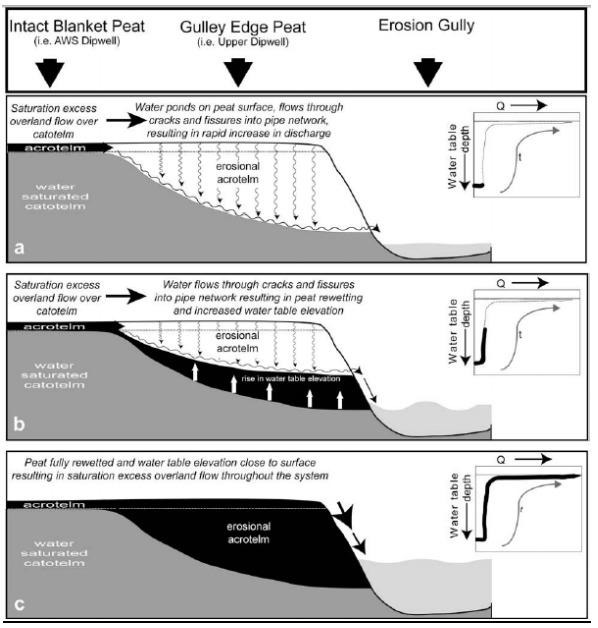Please Note: This is a Military Training Area on which live firing and other pyrotechnics may be used. The area is generally open public access. One of the safety rules for public access is:- Do not, (and ensure that children do not) approach, touch or pick up any metal objects lying on the ground. Please obey all bylaws and locally posted information concerning times when the area may be closed. These may be physical barriers, marker posts, flags, lights or manned control posts.
Ockerton Court is a small pool of water located at the southern end of the army ring road in the Okehampton Firing Range. The pool occupies a slight depression on the long ridge, between Okement Hill and Cranmere Pool. It is said to dry up during long dry spells, but that the bed of the pool remains firm enough to walk across. The site is also an interesting location in terms of the hydrology of Dartmoor. The upper moorland area, more specifically the peat bogs, is the source of a number of Devon's longest and most well known rivers. These include the Teign, Dart, Avon, Erme, Yealm, Plym, Tavy, Okement and Taw. As anyone who has walked Dartmoor will know, Dartmoor has a high level of rainfall, and this water is often stored in the ground. Although this may make for treacherous walking, the storage and movement of this groundwater is both highly important and very interesting. The boggy area to the south of Ockerton Court is the direct source for three of the aforementioned rivers, as well as the Black Ridge Brook, which later flows into the Teign.
Hydrology is the branch of earth science that focuses on the properties of earth's water, especially in its movement in relation to the land. The water cycle, which is commonly taught at school, is a basic outline of the cyclical movement of water around the globe. The water evaporates into the air, from numerous sources, where is condenses into water vapour, forming clouds. From there water falls as rain and flows along the land, until it reaches the sea. Obviously this is overly simplistic and in particular once water has fallen as rain there are many processes that affect the water and either how it reaches the sea, or is stored.
In the UK, 70% of all drinking water is derived from surface water, which in turn predominently comes from peat-dominated upland areas. These areas include different types of bogs, with Blanket Bogs and Raised Bogs being two of the more notable verities. Rivers, which are fed by peatland areas, are obviously directly affected by the unique properties that they possess. One very obvious characteristic of peatland area is the springiness of the peat itself, which is made up of semi-decomposed organic material (mainly vegetation). This means that even during long dry spells the peat retains a large volume of water, even if the surface of the peat appears dry.
The peat itself comprises of two main layers. The acrotelm is found at the surface, and is typically the least decomposed material. The catotelm is found below the acrotelm and is normally made up of much more decomposed, and therefore compact, material. The different layers, largely thanks to the levels of decomposition, have different hydrological properties. The acrotelm is the zone where the water table typically fluctuates based on rainfall, and water flows through it relatively easily. The catotelm on the other hand remains almost constantly saturated and due to the well decomposed material being very compact the rate of flow here is very low. That means that water in the catotelm will take a lot longer to be expelled from a peat bog than the recently added water in the acrotelm layer.
Because the majority of the water flow in peatland areas is from relatively freshly fallen rain in the upper parts of peat. The flow regimes (which are the rates of water entering a river) of most of Dartmoor's rivers is most closely linked to rainfall than rivers that have their sources on different geologies, where water moves at a relatively constant rate. However, the water table in peat is usually much higher than these other types of geology. That means that areas such as Ockerton Court and Cranmere Pool may well have standing water/pools even during lengthy period of little or no rainfall. This also goes to explain why Dartmoor, and other peat dominated areas, tend to have pools/boggy areas in places that would normally be dry.

A representation of how water tables work in peat

Generic non-peat water table diagram
In most geologies groundwater will filter through the ground until it meets an impermeable type of rock, at which point the water table will level off. As a result higher areas tend to have a 'thinner' band of saturated ground, with water gathering in the lower areas. This leads to higher areas being drier, with hollows and bottom of valleys being wetter. The properties of peat mean that this general rule is far less notable. Because the catotelm retains water, in peat the water table tends to be a more regular distance from the ground surface. This means that as well as hollows and valley collecting water, both higher areas and relatively steep slopes can also be very wet/boggy.
To log this EarthCache please go to the posted coordinates and send me your answers to these questions either through the messenger service or email.
1) Estimate the dimensions of the pool.
2) Walk around and look at the ground surrounding the pool, is it dry or can you see evidence for the water table being just below the surface?
3) Look at the peat bank near the posted coordinates, does the elevated peat bank show evidence for water retention, even though it is proud above the surrounding ground surface?
4) Looking at the topography immediately surrounding the pool, why do you think that the pool has collected here?